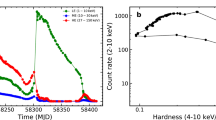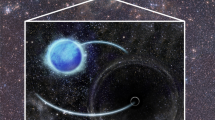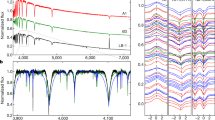Abstract
Black hole binary (BHB) systems comprise a stellar-mass black hole and a closely orbiting companion star. Matter is transferred from the companion to the black hole, forming an accretion disk, corona and jet structures. The resulting release of gravitational energy leads to the emission of X-rays1. The radiation is affected by special/general relativistic effects, and can serve as a probe for the properties of the black hole and surrounding environment, if the accretion geometry is properly identified. Two competing models describe the disk–corona geometry for the hard spectral state of BHBs, based on spectral and timing measurements2,3. Measuring the polarization of hard X-rays reflected from the disk allows the geometry to be determined. The extent of the corona differs between the two models, affecting the strength of the relativistic effects (such as enhancement of the polarization fraction and rotation of the polarization angle). Here, we report observational results on the linear polarization of hard X-ray emission (19–181 keV) from a BHB, Cygnus X-14, in the hard state. The low polarization fraction, <8.6% (upper limit at a 90% confidence level), and the alignment of the polarization angle with the jet axis show that the dominant emission is not influenced by strong gravity. When considered together with existing spectral and timing data, our result reveals that the accretion corona is either an extended structure, or is located far from the black hole in the hard state of Cygnus X-1.
This is a preview of subscription content, access via your institution
Access options
Access Nature and 54 other Nature Portfolio journals
Get Nature+, our best-value online-access subscription
$29.99 / 30 days
cancel any time
Subscribe to this journal
Receive 12 digital issues and online access to articles
$119.00 per year
only $9.92 per issue
Buy this article
- Purchase on Springer Link
- Instant access to full article PDF
Prices may be subject to local taxes which are calculated during checkout



Similar content being viewed by others
References
Remillard, R. A. & McClintock, J. E. X-ray properties of black-hole binaries. Annu. Rev. Astron. Astr. 44, 49–92 (2006).
Makishima, K. et al. Suzaku results on Cygnus X-1 in the low/hard state. Publ. Astron. Soc. Jpn 60, 585–604 (2008).
Fabian, A. C. et al. On the determination of the spin of the black hole in Cyg X-1 from X-ray reflection spectra. Mon. Not. R. Astron. Soc. 424, 217–223 (2012).
Webster, B. L. & Murdin, P. Cygnus X-1-a spectroscopic binary with a heavy companion? Nature 235, 37–28 (1972).
Miniutti, G. & Fabian, A. C. A light bending model for the X-ray temporal and spectral properties of accreting black holes. Mon. Not. R. Astron. Soc. 349, 1435–1448 (2004).
Frontera, F. Spectral and temporal behavior of the black hole candidate XTE J1118+480 as observed with BeppoSAX. Astrophys. J. 592, 1110–1118 (2003).
Basak, R., Zdziarski, A. A., Parker, M. & Islam, N. Analysis of NuSTAR and Suzaku observations of Cyg X-1 in the hard state: evidence for a truncated disc geometry. Mon. Not. R. Astron. Soc. 472, 4220–4232 (2017).
Lightman, A. P. & Shapiro, S. L. Spectrum and polarization of X-rays from accretion disks around black holes. Astrophys. J. Lett. 198, L73–L75 (1975).
Chauvin, M. et al. Calibration and performance studies of the balloon-borne hard X-ray polarimeter PoGO+. Nucl. Instrum. Meth. A 859, 125–133 (2017).
Stirling, A. M. et al. A relativistic jet from Cygnus X-1 in the low/hard X-ray state. Mon. Not. R. Astron. Soc. 327, 1273–1278 (2001).
Fender, R. P. A transient relativistic radio jet from Cygnus X-1. Mon. Not. R. Astron. Soc. 369, 603–607 (2006).
Reid, M. J., McClintock, J. E., Narayan, R., Gou, L., Remillard, R. A. & Orosz, J. A. The trigonometric parallax of Cygnus X-1. Astrophys. J. 742, 83–87 (2011).
Walton, D. J. et al. The soft state of Cygnus X-1 observed with NuSTAR: a variable corona and a stable inner disk. Astrophys. J. 826, 87–99 (2016).
Chandrasekhar, S. Radiative Transfer (Dover Publications, New York, 1960).
Dovciak, M., Muleri, F., Goosmann, R. W., Karas, V. & Matt, G. Light-bending scenario for accreting black holes in X-ray polarimetry. Astrophys. J. 731, 75–89 (2011).
Dovciak, M., Muleri, F., Goosmann, R. W., Karas, V. & Matt, G. Polarization in lamp-post model of black-hole accretion discs. J. Phys. Conf. Ser. 372, 012056 (2012).
Schnittman, J. D. & Krolik, J. H. X-ray polarization from accreting black holes: coronal emission. Astrophys. J. 712, 908–924 (2010).
Beloborodov, A. M. Plasma ejection from magnetic flares and the X-ray spectrum of Cygnus X-1. Astrophys. J. Lett. 510, L123–L126 (1999).
Done, C., Gierlinski, M. & Kubota, A. Modelling the behaviour of accretion flows in X-ray binaries. Everything you always wanted to know about accretion but were afraid to ask. Astron Astrophys Rev. 15, 1–66 (2007).
Nowak, M. et al. Corona, jet and relativistic line models for Suzaku/RXTE/Chandra-HETG observations of Cygnus X-1 hard state. Astrophys. J. 728, 13–41 (2011).
Niedzwiecki, A., Zdziarski, A. A. & Szanecki, M. On the lamppost model of accreting black holes. Astrophys. J. Lett. 821, L1–L5 (2016).
De Marco, B. et al. Evolution of the reverberation lag in GX 339-4 at the end of an outburst. Mon. Not. R. Astron. Soc. 471, 1475–1487 (2017).
Ohsuga, K., Mineshige, S., Mori, M. & Kato, Y. Global radiation-magnetohydrodynamic simulations of black-hole accretion flow and outflow: unified model of three states. Publ. Astron. Soc. Jpn 61, L7–L11 (2009).
Miller, J. M. et al. New constrains on the black hole low/hard state inner accretion flow with NuSTAR. Astrophys. J. Lett. 799, L6–L15 (2015).
Reynolds, C. S. Measuring black hole spin using X-ray reflection spectroscopy. Space Sci. Rev. 183, 277–294 (2014).
Merloni, A., Heinz, S. & di Matteo, T. A fundamentral plane of black hole activity. Mon. Not. R. Astron. Soc. 345, 1057–1076 (2003).
Zanin, R. et al. Gamma rays detected from Cygnus X-1 with likely jet origin. Astron. Astrophys. 596, A55 (2016).
Albert, J. et al. Very high energy gamma-ray radiation from the stellar mass black hole binary Cygnus X-1. Astrophys. J. Lett. 665, L51–L54 (2007).
Orosz, J. A. The mass of the black hole in Cygnus X-1. Astrophys. J. 742, 84–93 (2011).
Ziolkowski, J. Determination of the masses of the components of the HDE 226868/Cyg X-1 binary system. Mon. Not. R. Astron. Soc. Lett. 440, L61–L65 (2014).
Agostinell, S. et al. Geant4-a simulation toolkit. Nucl. Instrum. Meth. A 506, 250–303 (2003).
Matsuoka, M. et al. The MAXI mission on the ISS: science and instruments for monitoring all-sky X-ray images. Publ. Astron. Soc. Jpn 61, 999–1010 (2009).
Krimm, H. et al. The Swift/BAT hard X-ray transient monitor. Astrophys. J. Suppl. S. 209, 14–46 (2013).
Mitsuda, K. et al. The X-ray observatory Suzaku. Publ. Astron. Soc. Jpn 59, S1–S7 (2007).
Chauvin, M. et al. Shedding new light on the Crab with polarized X-rays. Sci. Rep. 7, 7816–7821 (2017).
Russell, D. M. & Shahbaz, T. The multiwavelength polarizatoin of Cygnus X-1. Mon. Not. R. Astron. Soc. 43, 2083–2096 (2014).
Long, K. S., Chanan, G. A. & Novick, R. The X-ray polarization of Cygnus sources. Astrophys. J. 238, 710–716 (1980).
Laurent, P. et al. Polarized gamma-ray emission from the Galactic black hole Cygnus X-1. Science 332, 438–439 (2011).
Jourdain, E., Roques, J. P., Chauvin, M. & Clark, D. J. Separation of two contributions to the high energy emission of Cygnus X-1: polarization measurements with INTEGRAL SPI. Astrophys. J. 761, 27–34 (2012).
Markoff, S., Falcke, H. & Fender, R. A jet model for the broadband spectrum of XTE J1118+480: synchrotron emission from radio to X-rays in the Low/Hard spectral state. Astron. Astrophys. 372, L25–L28 (2001).
Matt, G. X-ray polarization properties of a centrally illuminated accretion disc. Mon. Not. R. Astron. Soc. 260, 663–674 (1993).
Acknowledgements
This research was supported in Sweden by The Swedish National Space Board, The Knut and Alice Wallenberg Foundation, and The Swedish Research Council. In Japan, support was provided by Japan Society for Promotion of Science and ISAS/JAXA. SSC are thanked for providing expert mission support and launch services at Esrange Space Centre. DST Control developed the PoGO+ attitude control system under the leadership of J.-E. Strömberg. Contributions from past Collaboration members and students are acknowledged. In particular, we thank M. Kole, E. Moretti, G. Olofsson and S. Rydström for their important contributions to the PoGOLite Pathfinder mission from which PoGO+ was developed.
Author information
Authors and Affiliations
Contributions
M.C., H-G.F., M.F., M.J., T.Kam., J.K., T.Kaw., M.K., V.M., T.M., N.O., T.S., H.T., H.Tak., N.U. and M.P. contributed to the development of the PoGO+ mission concept and/or construction and testing of polarimeter hardware and software. Observations were conducted by M.C., H-G.F., M.F., M.K., V.M., T.S., H.Tak., N.U. and M.P. Data reduction and analysis was performed by M.C., M.F., M.K., V.M., H.Tak. and M.P. The manuscript was prepared by M.F., M.K., V.M., H.Tak. and M.P. The mission principal investigator is M.P.
Corresponding author
Ethics declarations
Competing interests
The authors declare no competing interests.
Additional information
Publisher’s note: Springer Nature remains neutral with regard to jurisdictional claims in published maps and institutional affiliations.
Supplementary information
Supplementary Information
Supplementary Figure 1–12, Supplementary Table 1.
Rights and permissions
About this article
Cite this article
Chauvin, M., Florén, HG., Friis, M. et al. Accretion geometry of the black-hole binary Cygnus X-1 from X-ray polarimetry. Nat Astron 2, 652–655 (2018). https://doi.org/10.1038/s41550-018-0489-x
Received:
Accepted:
Published:
Issue Date:
DOI: https://doi.org/10.1038/s41550-018-0489-x



